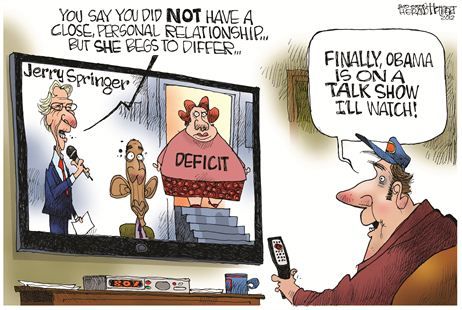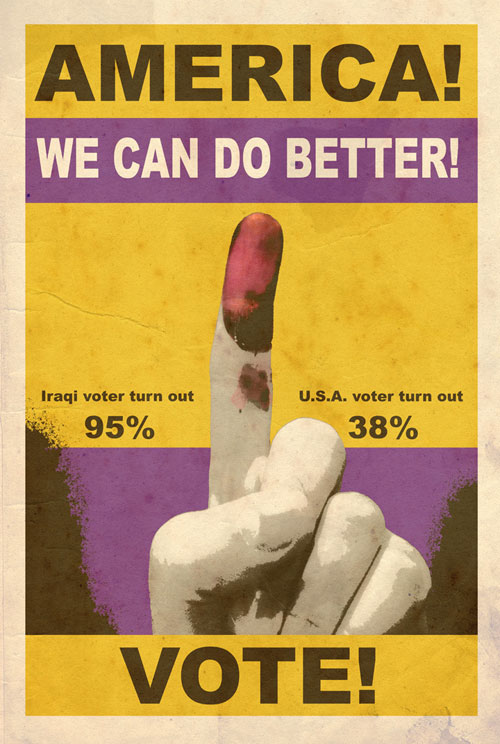
TPN: Sadly, this obsession over what has to be the most misunderstood science in all of American life has become a ritual, with a life all its own. So, now the depression is full bore, and even people on the Republican side are beginning to show signs of depression, despite all of our solid promises to ourselves and each other that this year, we would not fall for this lunacy, no matter what. If you really believe that the worst President in our Nation's history, the man who's policy of appeasement has seen a quarter of our embassies around the world set ablaze, the man who's domestic policies have shut down all domestic energy production on federal lands, the man who's economic policies have made him the first President since Herbert Hoover to see less Americans working after a full term in office than on the day he was sworn into office, will win the election by 8 to 10 points, then I happen to be in possession of the Brooklyn Bridge, and would be willing to sell.
What is most perplexing to me about the devotion to the polls is this. If the polls were at all accurate, they would be very close to delivering us the same numbers. If that were the case, nobody would be logging onto the Real Clear Politics website in order to see what the daily average of all the polls had to say about the daily average of all polls where every poll should be mirroring the daily average.
Consider this also, after every election cycle, all of the polls are ranked in accuracy, and surprisingly, none of the polls being quoted anywhere by anyone are ever close to the top of that list. Rasmussen and Zogby will typically rank 1 and 2, and neither will be discussed on the evening news. We'll discuss both of these companies later, and why they get closer than the other more famous members of the polling community.
What is a better predictor of election results is history, and in that spirit, Dick Morris has an analysis that is probably much more predictive than anything you'll see in the polls. In his article, Dick Morris combines an historical perspective with the polling results to give us what I believe to be one of the best predictive analyses available
So here’s where the race really stands today based on Rasmussen’s polling:
• Romney leads decisively in all states McCain carried (173 electoral votes).
• Romney is more than ten points ahead in Indiana – which Obama carried. (11 electoral votes)
• Romney leads Obama in the following states the president carried in 2008: Iowa (44-47) North Carolina (45-51), Colorado (45-47), and New Hampshire (45-48).He’ll probably win them all. (34 electoral votes).
This comes to 218 of the 270 Romney needs. But…• Obama is below 50% of the vote in a handful of key swing states and leads Romney by razor thin margins in each one. All these states will go for Romney unless and until Obama can show polling support of 50% of the vote:
• Obama leads in Ohio (47-46) and Virginia (49-48) by only 1 point (31 electoral votes)
• Obama leads in Florida (48-46) and Nevada (47-45) by only 2 points (35 electoral votes)
If Romney carries Ohio, Virginia, and Florida, he wins. And other states are in play.
• Obama leads in Wisconsin (49-46) by only 3 points (10 electoral votes)
• Obama’s lead in Michigan is down to four points according to a recent statewide poll
• Obama is only getting 51% of the vote in Pennsylvania and 53% in New Jersey. And don’t count out New Mexico.
It would be accurate to describe the race now as tied. But Romney has the edge because:
• The incumbent is under 50% in key states and nationally. He will probably lose any state where he is below 50% of the vote.
• The Republican enthusiasm and likelihood of voting is higher
• The GOP field organization is better.
That’s the real state of play today.
When a pollster conducts his interviews, he does not contact only the number of people reported in the headline. They will usually contact 3 to 4 times that number of people. You will also not see the actual breakdown of how people responded in the headline. What you see, his finished product, will be a weighted average based on what the pollster feels will be the demographic distribution of who will ultimately vote, in other words, his guess.
Typically, when interviews are conducted, a voting model of demographic distribution exists before hand. A certain percentage of women, men, breakdowns by age, race, religion, party affiliation, etc. Then percentages of how each demographic would vote is the information gleaned from the polling interviews. For instance, pretty much all of the pollsters agree today that Barack Obama would win 85% of the democrats who voted, and Mitt Romney would likely garner 86% of the Republicans who voted. What is in dispute is how the voting demographic will break down. How many 18 to 21 year old kids this time? Four years ago, that demographic turned out huge for Barack Obama, now that 50% of them have remained unemployed for the entirety of Barack Obama's term in office, and they are 4 years older, will they turn out in the same force? Will today's crop of 18 to 21 year old voters vote in similar fashion as their counterparts from 4 years ago? Typically, this demographic has an abhorrent track record when it comes to voting.
What you have at the end of the day is this. Polls are only going to be as accurate as their predictions as to what the demographic make up of the actual voting sample turns out to be. What PPP, Marist, Quinipiac, USA Today, are telling us with their samples is that the voting make up this year will look exactly as the make up looked in 2008. In 2008, Goerge W. Bush was despised almost universally, albeit unjustly, and the Democrats in our country were hyped up as never before for their man Barack Obama. He was viewed as somewhat of a messianic figure during the height of the hopety change fervor that had gripped the nation's dopes. My fellow citizens were chanting, in a scene that came straight out of 1930's Germany. What these polls are telling us, is that America is still in that mood today.
Think about this for one moment. Compare the size of the crowds traveling to see Mitt Romney and Paul Ryan. Consider the difference in size of the Tea Party crowds to the faked inhabited tents of the Occupests. Twice since the convention, and once during it, Barack Obama was forced to change venues to something smaller due to a lack of attendance.
Pollster Scott Rasmussen has the best solution to the party id problem. He weights his polls to reflect the unweighted party identification of the previous three weeks, so he has a dynamic model which adjusts for sampling error but still takes account of gradual changes in the electorate’s partisan preferences.
First off, Rasmussen asks the question up front, do you plan on voting. This alone gives his poll an accuracy that the others lack. Registered voter polls include a bias towards the demographics who typically do not vote. Next, Rasmussen uses a different interview process to gain some understanding of what this year's model will actually resemble, without relying on data from 4 years ago. One of the things Rasmussen has found, through polling independent of the question of who will we be voting for, is that people who self identify as Republican is at an all time high. People who self identify as Democrat is at a near historic low. This does not exactly lead one to the conclusion that 2008's record turnout of every Democrat demographic feels that same enthusiasm today, and indeed feels it to an even greater degree.
In the case of Zogby this year, kudos for changing methodology to reflect changes in the level of technology available to citizens. My fear is that he does not yet have a handle of how to accurately utilize his new methodology. Zogby has been extremely quiet this election cycle, and now we all know why. Rather than conducting phone interviews, John Zogby and his company conducted on line interviews. I have seen far too many of these types of polls skewed purposefully, not by the polling companies, but by spammers with an agenda finding holes in the programming sufficient to deliver a result desired. the perfect examples of this were highlighted in 2008, when any online poll of the Republican Primary race showed Ron Paul with support ranging from 70% to 80% of any sample, while he consistently garnered only 2% of the actual vote. I am not saying that Zogby has not found a way to combat this, but his only poll to date this year seems to be somewhat of an outlier, even when compared to the others. I wish John Zogby the best in getting a handle on his new methodology, if successful, it should be a quantum leap in the art.
At this point during the election of 1980, Jimmy Carter supposedly had an 8 point lead over Ronald Reagan. I realize that Mitt Romney is no Ronald Reagan, but neither is Barack Obama a Jimmy Carter. I am not one of those people who will jump up and down to swear that this is some nefarious plot on the part of all things liberal. I just believe the pollsters to be dead wrong, and that would not make the first time either. In 2004, NBC announced at about noon on election day that our 44th President would be John Kerry, based on their exit polls, which had the benefit of an accurate voting sample.
Cross Posted from Musings of a Mad Conservative.
Related:
The Reality of 2012 Voter Turnout: The White Voter
‘Unskewed’ polls show nearly 8-point Romney lead
Race beginning to look a lot like 1980? What might Ronald Reagan’s victory path mean?
Calling All Concerned Americans to Stand-Up





























